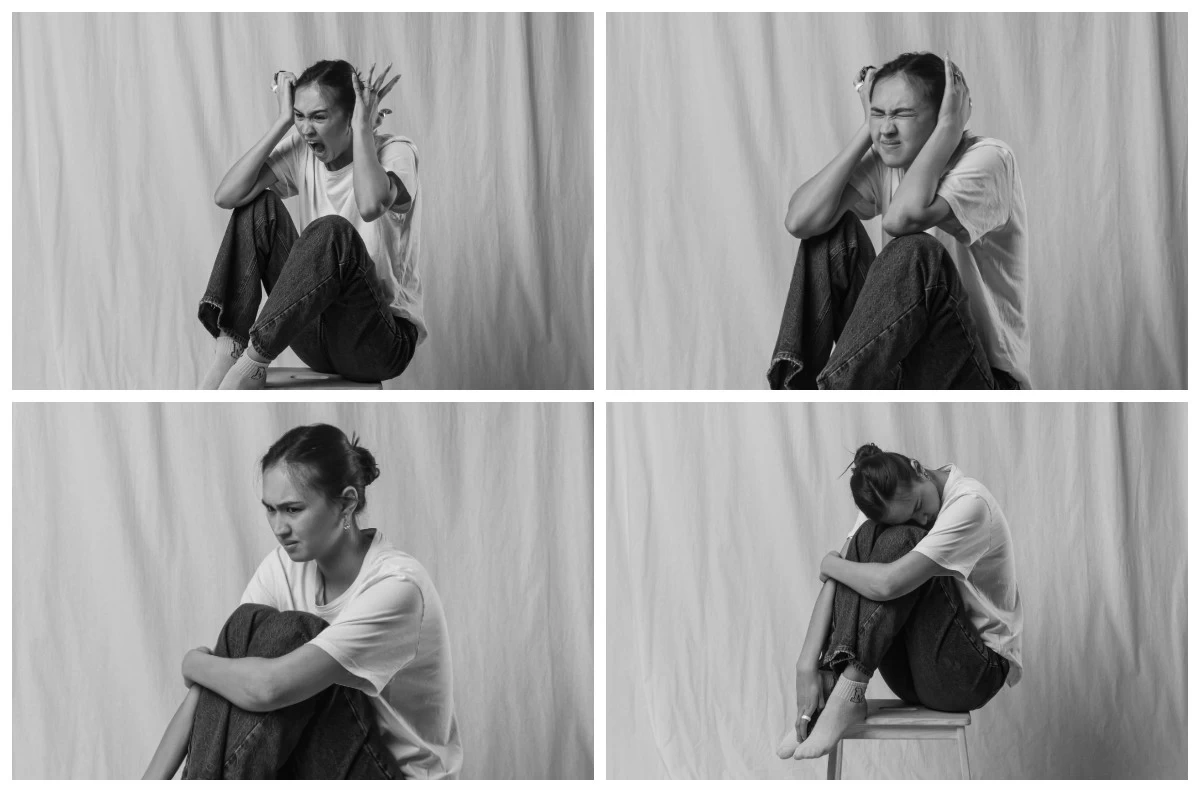23 жастағы блогер Малика Атақановаға жақында ғана аутизм спектрінің бұзылуы диагнозы қойылды. Ол қазір өзінің блогында ересектерде кездесетін аутизм және онымен өмір сүру туралы көп айтып жүр. Негізі бойындағы кейбір жайттардың жауабын білгісі келіп, 13 жасынан ізденген. Психология, эзотерика, коучинг – адамның ішкі жандүниесіне қатысты өте көп ақпарат оқып, өзінде не дұрыс емес екенін білгісі келген. Содан бір күні АСБ (аутизм спектрінің бұзылуы) туралы ақпаратқа тап болып, ұқсастықтарды көп байқап, психиатрға жазылған. Stan.kz ақпарат агенттігі Маликаға хабарласып, ересектерде болатын аутизм туралы толығырақ сұрады.
Фото Малика Атақанованың жеке архивінен
Кез келген бір синдром, бұзушылық – бәрі маған сай келмеді, сипаттамалары менікіне ұқсамады дейді ол. Содан бір күні аутизм спектрінің бұзылысы туралы ақпаратты кезіктіріп, оны екі айдай зерттеген. Кейін психиатрға барып, өзінің аутист екенін білген. Диагноз қойған маман аутизм спектрінің бұзылуы туралы жақсы біледі және оның тіпті осы тақырып бойынша ғылыми жұмысы да бар екен.
“Синдромдардың бәрін қайта-қайта оқи бердім, тіпті жаттап алдым деуге болады. Өзімнен байқаған әрекеттерді анализдеуге тырыстым, жақсы маман іздедім. ТМД елдерінде, орысша ортада аутизм спекторының бұзылысы туралы жақсы білетін маман табу өте қиын. Орысша адекватты ақпарат та жоқтың қасы. Бұрын аутистерді ақыл-есі кем деп есептеп, антидепрессант беріп, психикалық емханаға жатқызған. Жоғары функциялы аутистер туралы мүлдем әңгіме болмаған. Оларға әрі кетсе шизофрения деп диагноз қойған. Іздеп жүріп, ауқымды қоғамдастық бар екенін білдім. Олардан мықты деген психиатрлардың аты-жөнін, мәліметін алдым. Соңында Сербияда тұратын психиатрмен кездестік, ол маған осындай диагноз қойды. Мұндай диагнозды қою өте қиын. Себебі симптомдар өте көп”, – дейді ол.
Дегенмен өзінің осы диагнозын жақсы нышан ретінде қабылдапты.
“Жоғары функциялы аутизммен ауыратындықтан, мен мұны артықшылық ретінде қабылдаймын. Менің IQ-ым жоғары, миым стандарттан тыс. Әлемді көп өлшемді түрде көремін. Бұл маған көп шығармашылық идеялар береді. Мен мұны “нәзіктік” деп қабылдаймын. Өйткені диагнозым өзімнің психикалық денсаулығыма өте сезімтал түрде мұқият болуды, қамқорлық жасауды, жұмсақтықты талап етеді”, – дейді Малика.
Ересек кездегі аутизм қалай сезіледі?
Ол өзінің оқырмандарына аутизм тек бір бұрышта тізеңді құшақтап, теңселіп отыру емес екенін айтып жүр. Малика бізге аутизм қалай сезілетінін түсіндіріп берді.
“Иә, аутизм осындай да болады. Ол бір бұрышта тізеңді құшақтап, теңселіп отыру емес. Аутизмі бар адам қалыпты өмір сүреді, күнделікті тірліктерді істеп жүре алады. Ол да жоғары функциялы бола алады, яғни аутизмі бар адамды бағып-қақпаса да болатын жағдайлар бар. Кей жерде тіпті аутист деп айтпайды, көбіне спектор бұзылысы бар адам дейді. Сырттағы, қоғамдағы өмірді сүресің, бірақ үнемі іште боласың. Назарың, сезімдерің, түйсігің үнемі іште, тереңде. Сырттағы әлемді сезіну, одан әсерлену қиын болады. Бүкіл сенсорлық ерекшеліктеріңнің бәрі максимум жұмыс істейді. Жарық, иіс, дыбыс және тағы басқасын қаттырақ, күшейтілген түрде сезінесің. Мен маскинг тағып өмір сүрдім, яғни сезімдерді, әсерімді жасырып, күшейіп тұрғанын байқатпай жүрдім (әлеуметтік камуфляж – аутизм бұзылысы бар адамдар қоғамда бәрімен теңдей болу үшін жаттанды іс әрекеттерді жасап, өзінің сезімдерін жасыруы). Сөйлеуімде бұзылыс жоқ, бірақ коммуникация құрғанда қиналамын. Мұнымды көп адам байқамай қалатын. Бірақ кейінгі кезде айналам үшін жүріс-тұрысымды өзгертуге тырыспаймын”, – дейді ол.
Дегенмен ол аутизм өзгелермен қарым-қатынаста байқалады әрі қиындатады дейді. Малика бұрыннан сезімтал болған. Мұнысын кемшілік деп санап та келіпті. Ал қазір мұны ерекше артықшылыққа балайды.
“Диагнозым құрбыларыммен қарым-қатынаста көп шектеу жасады. Мектепте де, аулада да мені әпенді деп санайтын. Достасуға қиналатынмын, ыңғайсыз жағдайларға жиі ұшырайтын едім. Бұл менің көп нәрседен бас тартуыма әсер етіп, (шамадан тыс бас тарту сезімі) салдарынан өзімді төмен бағалауыма себеп болды. Бірнәрсеге лайық екенімді жиі жоққа шығаратынмын. Мысалы, “Ел аруы” байқауына қатысуға шақырудан екі рет бас тарттым. Диагноз қойылмағаннан және соған сай өзімді дұрыс күте алмағандықтан қатты депрессияны бастан өткердім. Бірақ осы азаптың бәрі мені адам психикасын, жан дүниесін көп зерттеуге итермеледі. Ал қазір мен ересек адам ретінде өзіммен жақсы, тұрақты қарым-қатынас құра алдым.
“Аутистік күйіп кету”, сонымен қатар “шектен тыс сенсорлық жүк” деген термин бар. Мұндай кезде адамның өте қарапайым істерді істеуге мүлдем құлшынысы болмай қалатын көрінеді. Қарапайым өз төсегіңе жату, аузыңды шаю және тағы басқа. Малика мұндай күй кезінде қалай әрекет ететінін айтып берді.
“Осындай күйіп кеткен кездерде тісімді жуу немесе төсектен тұру қиынға соғады. Ең сорақысы, мұндай сәттерде қандай да бір кездесулер өткізіп, көп ақпаратты және жалпы кез келген дыбысты, көріністерді өңдеу керек болады. Ал ресурсым қалыпты болған кезде өзімнің “жоғары сезімталдығыма” сай өмір сүруге тырысамын. Заттарды баяу қабылдаймын, санамды тітіркендіретін дүниелерден аулақ болып, таңғы ас дайындау сияқты әр кішкентай нәрсе үшін өзімді мақтауға тырысамын. Жұмыс істегенде немесе адамдармен сөйлескенде сенсорлық шамадан тыс жүктеме бар-жоғын бақылап отыруға тура келеді, өйткені оған түсіп қалу өте оңай”, – дейді ол.
Малика ақпаратты естігенде түсінбей, қайта-қайта сұрайтынын, кейбір әңгімелерді тым терең қабылдайтынын да қоса кетті.
“Шағын ғана әңгімелерді шынымен түсінбеймін. Тек мағынасы бар терең әңгімелерді жақсы көремін. Менің аутист миым көбіне ақпаратты сөзбе-сөз қабылдайды да, кейде сөздердің мағынасын түсінгенше бала сияқты қайталап сұрауым мүмкін. Иә, адамдармен коммуникация құруда проблемалар бар. Соған қарамастан, жаңа таныстықты ұнатамын. Қарым-қатынаста харизмамды пайдаланған ұнайды. Камера алдында сөйлеп, блог жүргізуді жақсы көремін.
Маскинг деген не? Аутистер неліктен маска тағады?
Ересек аутистің айтуынша, олар балаларға қарағанда қоғамдық ортада, адамдар арасында жаттанды әрекеттерді орындап жүре алады. Бірақ ұзақ емес. Осы жаттанды жүруді маскинг деп атайды.
“Біз қоғамда өзімізді шынайы емес, жаттанды түрде ұстаймыз. Сондықтан басқаларға ұқсау үшін секунд сайын мимикамызды, сөйлесу мәнерімізді, дауыс ырғағын, мінез-құлқымызды саналы түрде бақылап отыруға көп күш жұмсаймыз. Бұдан шаршайтынымыз сонша, қысқа әңгімеден кейін бірнеше күн жоқ болып кете аламыз. Сол үшін кейде өзім контрольді босатуға тырысамын. Қазір немқұрайлы қарап, шынымен қызықпайтынымды, түсінбей отырғанымды көрсете беремін. Жауап бермес бұрын ұзақ уақыт қарап, ойланып отырамын”, – дейді ол.
Өзінің сөзінше, маскингтен тыс уақытта ол өзімен-өзі, шынайы бола алады. Ал қазір тіптен маска тағып алуды қойдым дейді. READ FULL STORY HERE>>>CLICK HERE TO CONTINUE READING>>>
“Біртүрлі, тежелген болып көрінуім мүмкін, бірақ осылай шынайы боламын. Кішкене сергу үшін қолымды жан-жақа бұлғап, жаттығамын, секіремін, орындықта отырып тербелемін, барлық әшекейімді шешіп, қайтадан тағамын, әртүрлі дыбыстар шығарамын. Әзілдерді, кеңестерді түсінбей қаламын және жай күле саламын. Немесе бәрі күліп болған соң қайта айтуын сұраймын.
Аутист адамдар жоғары сезімталдығына байланысты өте оңай қорқады немесе ренжіп қалады. Ішкі сезімдерімізді көрсетудің немесе кетіп қалудың орнына ішімізді өртеп бара жатқан сезімдерді жасырып, “жүзімізді бір қалыпты ұстай аламыз”. Бірақ мен орнымнан тұрып, өзімді ыңғайсыз сезінетін жерлерден кетіп қалуды үйрендім”, – дейді Малика.
 Фотода аутистердің маскадан тыс эмоциялары көрсетілген. Фото Малика Атақанованың жеке архивінен
Фотода аутистердің маскадан тыс эмоциялары көрсетілген. Фото Малика Атақанованың жеке архивінен
Аутистер туралы нені білген жөн?
Әр аутист те басқа адамдар сияқты әртүрлі болады. Олар өзге адамдардың жай-күйін, ішкі толғаныстарын жақсы байқайды және сезініп отыратын көрінеді.
“Аутизммен ауыратын адамдар бүкіл өмірін басқа адамдардың мінез-құлқын талдаумен өткізеді деуге болады. Олар мұны сол мінез-құлықтарды өздеріне маска ретінде тағуға қолдану үшін жасайды. Осылайша адамдарды, олардың әдеттері мен реакцияларын жақсы түсінеміз. Бұл оларға жақсы әсер етуімізге, қажет мүмкіндіктерді пайдалануымызға көмектеседі. Оған қоса гиперфиксация да болып тұрады. Мұндай сәттерде көп мөлшердегі ақпаратты өңдей отырып, 10-12 сағат үздіксіз жұмыс істей аламын немесе бір нәрсені зерттей аламын. Ол кезде тамақ, ұйқы және басқа қажеттіліктерді ұмытып кетемін. Иә, бұл онша сау нәрсе емес. Бірақ гиперфиксация өмірде және тапқыр ойлауда өте керемет нәтиже береді”, – дейді Малика Атақанова.
Ол мұндай диагнозбен өмір сүргенде өзіңе көмек сұрап, қамқорлық жасай алу өте маңызды дейді. Ал өзі мұны аутизм бар екенін анықтағанша үйренуге тырысыпты. Малика 15 жасынан бастап басқа елде, ата-анасынан бөлек тұрып, дағдыланған. Сол жасынан бері модель болып жұмыс істейді. Ол осындай диагнозын ашық жариялап, өзінің блогында аутизм туралы айтады.
“Мен көмек пен қолдау сұрауды диагноз қойылғанға дейін үйрене бастадым. Өйткені депрессия немесе паникалық шабуыл кезінде керек болатынын түсіндім. Кішкентай кезімде өте сабырлы, талапсыз бала болғандықтан, ата-анам тәуелсіз өмір сүруіме ерте бастан мүмкіндік берді. Бұл мені ересек адам ретінде өзіме қажет нәрсені дауыстап айтуды үйренуге итермеледі”, – деді блогер.
Қоғам ересек аутистерді қалай қабылдап жүр?
Блогердің жақындары оның аутизм туралы деректерін қызығып тыңдайды екен.
Өйткені мен осы тақырып жөнінде үнемі ізденіп, хабардар болып отырмын. Сонымен қатар аутизм бұзылысы гені атадан балаға берілетіндіктен, туыстарым бұл диагноз өздерінде бар-жоғына күдіктене бастады. Менің ер адамым маған бұрынғыдан да қамқор бола түсті. Ол мені барынша түсінгісі келеді, әлемді қалай сезінетінімді білгісі келеді. Дегенмен әлеуметтік желіде мені жек көріп, жұрттың бәрін алдап жүргеніме сендіруге тырысатындар бар. Олардың арасынан психологтарды көріп қалсам, шошып кетемін. Өйткені мұндай маманнан адамдар жарақат алуы мүмкін. Мен сияқты адамдардың тәжірибесін қабылдау үшін қоғамға көбірек уақыт қажет.
Өзінің жақындары қолдағанымен, Маликаға әлеуметтік желідегі оқырмандар “Аутистке ұқсамайсыз” деп жиі жазады.
Кез келген басқа адам сияқты бізді де қоғам тыңдағанын, сезімдерімізді құнсыздандырмағанын қалаймыз. “Сіз аутистке ұқсамайсыз ғой” деген сияқты таптаурын сөздер бізге шынымен зиян тигізуі мүмкін. Өйткені аутизмнің сыртқы түрі жоқ. Адамдардың менімен мұқият сөйлесіп, диалог бастауға болатын-болмайтынын алдын ала сұрағанын қалаймын. Олар менің көзіме ұзақ қарамаса екен деймін. Менімен кездесу үшін адам көп және шулы жерлерді таңдамауын сұраймын. Алдын ала ескертіп, жоспарлап, бірнәрсені түсінбесем, түсіндіріп жібергенін қалаймын. Блогым арқылы мұндай адамдардың өмірін, іс-әрекетін норма еткім келеді. Аутизмі бар адамдарды қалыпты түрде қабылдау енді ғана басталған сияқты және мен бұған өз үлесімді қосқым келеді.
Сонымен қатар жас қыз өзгелерді аутизмді зерттеуге, бұл туралы біліп жүруге шақырды. Себебі айтуынша, аутистерге қатысты таптаурын көп.
“Біріншіден, мен адамдарға аутизм спектрінің бұзылуын зерттеуді ұсынар едім. Өйткені қазір аутист адамдардың өзін қалай ұстауы керек екені немесе сыртқы келбеті туралы таптаурындар жетеді. Аутизмді басқа диагноздармен жиі шатастырады немесе оған басқа диагноздарды қосып қояды. Сондықтан бізді көбіне дұрыс түсінбейді. Ал бұл адамдардың әлеуметтенуіне кесіріп тигізеді, қоғамнан қорқып қалуға ықпал етеді. Мен нейроерекше адамдардың қоғамдық орындарда және жұмыс орындарында арнайы тыныш бөлмелері немесе тыныш уақыты болғанын қалаймын. Сол кезде біз сенсорлы түрде қалыпқа келіп, мелтдаун мен шатдаундарға (қатты үрей) ұшырамаймыз”, – деп үндеді ол.
Малика өзі сияқты диагноз қойылған адамдарға да кеңесін берді.
“Мүмкіндігінше тезірек өзіңізге қамқорлық жасаңыз. Егер психологқа барып, терапия аламын десеңіз, маман диагнозыңыз туралы жан-жақты білетін адам болсын. Себебі бізді нейротиптік адам ретінде емдеу аяқ сынған кезде қолды емдегенмен бірдей. Ал егер аутизмі бар таныстарыңыз болса, оның ерекшеліктерін біліп, эмоциялық жай-күйінен хабардар болыңыз. Ол адамға тыныш, жайлы жағдай жасаңыз. Ең бастысы – оны дәл осы күйінде қабылдау. Толық қабылдау ғана бізге мықтап тағып алған маскамызды шешіп жүруге көмектеседі”, – деп түйіндеді Малика Атақанова.


 METRO11 months ago
METRO11 months ago
 IN-THE-NEWS2 weeks ago
IN-THE-NEWS2 weeks ago
 IN-THE-NEWS12 months ago
IN-THE-NEWS12 months ago
 SPORTS11 months ago
SPORTS11 months ago
 SPORTS11 months ago
SPORTS11 months ago
 METRO2 weeks ago
METRO2 weeks ago
 IN-THE-NEWS12 months ago
IN-THE-NEWS12 months ago



